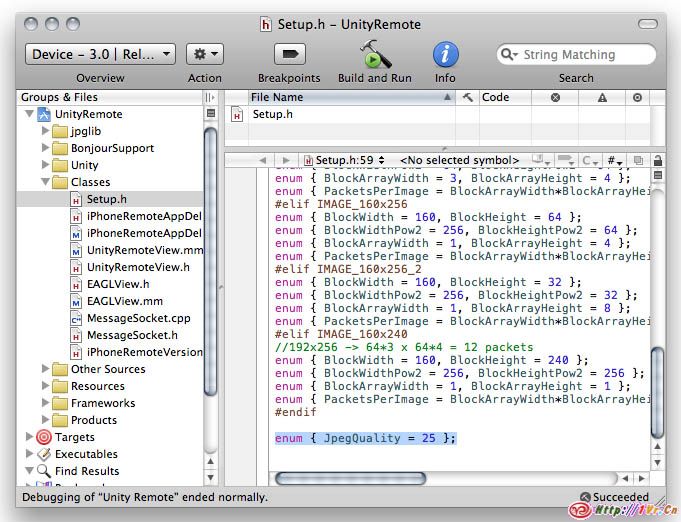将下面的脚本放在你项目目录下资源文件夹的Editor里.
要导出地形,首先在你的场景中选中地形对象.如果没选,他将用于当前场景中可用的地形.从Terrain菜单下选择Export To Obj… ,在分辨率窗口,选择你要四边形还是三角形网格结构.同样也可以选择要导出地形的分辨率,有高中低等等.点击Export,选择要保存的位置和文件名.Obj文件将被导出.要注意如果选择大面积的Full地形导出,最终的Obj文件将非常大,而且也要导出很久.
下面为ExportTerrain.js脚本.
import System.IO;
import System.Text;
enum SaveFormat {Triangles, Quads}
enum SaveResolution {Full, Half, Quarter, Eighth, Sixteenth}
class ExportTerrain extends EditorWindow {
var saveFormat = SaveFormat.Triangles;
var saveResolution = SaveResolution.Half;
static var terrain : TerrainData;
static var terrainPos : Vector3;
var tCount : int;
var counter : int;
var totalCount : int;
@MenuItem ("Terrain/Export To Obj...")
static function Init () {
terrain = null;
var terrainObject : Terrain = Selection.activeObject as Terrain;
if (!terrainObject) {
terrainObject = Terrain.activeTerrain;
}
if (terrainObject) {
terrain = terrainObject.terrainData;
terrainPos = terrainObject.transform.position;
}
EditorWindow.GetWindow(ExportTerrain).Show();
}
function OnGUI () {
if (!terrain) {
GUILayout.Label("No terrain found");
if (GUILayout.Button("Cancel")) {
EditorWindow.GetWindow(ExportTerrain).Close();
}
return;
}
saveFormat = EditorGUILayout.EnumPopup("Export Format", saveFormat);
saveResolution = EditorGUILayout.EnumPopup("Resolution", saveResolution);
if (GUILayout.Button("Export")) {
Export();
}
}
function Export () {
var fileName = EditorUtility.SaveFilePanel("Export .obj file", "", "Terrain", "obj");
var w = terrain.heightmapWidth;
var h = terrain.heightmapHeight;
var meshScale = terrain.size;
var tRes = Mathf.Pow(2, parseInt(saveResolution));
meshScale = Vector3(meshScale.x/(w-1)*tRes, meshScale.y, meshScale.z/(h-1)*tRes);
var uvScale = Vector2(1.0/(w-1), 1.0/(h-1));
var tData = terrain.GetHeights(0, 0, w, h);
w = (w-1) / tRes + 1;
h = (h-1) / tRes + 1;
var tVertices = new Vector3[w * h];
var tUV = new Vector2[w * h];
if (saveFormat == SaveFormat.Triangles) {
var tPolys = new int[(w-1) * (h-1) * 6];
}
else {
tPolys = new int[(w-1) * (h-1) * 4];
}
// Build vertices and UVs
for (y = 0; y < h; y++) {
for (x = 0; x < w; x++) {
tVertices[y*w + x] = Vector3.Scale(meshScale, Vector3(x, tData[x*tRes,y*tRes], y)) + terrainPos;
tUV[y*w + x] = Vector2.Scale(Vector2(x*tRes, y*tRes), uvScale);
}
}
var index = 0;
if (saveFormat == SaveFormat.Triangles) {
// Build triangle indices: 3 indices into vertex array for each triangle
for (y = 0; y < h-1; y++) {
for (x = 0; x < w-1; x++) {
// For each grid cell output two triangles
tPolys[index++] = (y * w) + x;
tPolys[index++] = ((y+1) * w) + x;
tPolys[index++] = (y * w) + x + 1;
tPolys[index++] = ((y+1) * w) + x;
tPolys[index++] = ((y+1) * w) + x + 1;
tPolys[index++] = (y * w) + x + 1;
}
}
}
else {
// Build quad indices: 4 indices into vertex array for each quad
for (y = 0; y < h-1; y++) {
for (x = 0; x < w-1; x++) {
// For each grid cell output one quad
tPolys[index++] = (y * w) + x;
tPolys[index++] = ((y+1) * w) + x;
tPolys[index++] = ((y+1) * w) + x + 1;
tPolys[index++] = (y * w) + x + 1;
}
}
}
// Export to .obj
try {
var sw = new StreamWriter(fileName);
sw.WriteLine("# Unity terrain OBJ File");
// Write vertices
System.Threading.Thread.CurrentThread.CurrentCulture = new System.Globalization.CultureInfo("en-US");
counter = tCount = 0;
totalCount = (tVertices.Length*2 + (saveFormat == SaveFormat.Triangles? tPolys.Length/3 : tPolys.Length/4)) / 1000;
for (i = 0; i < tVertices.Length; i++) {
UpdateProgress();
var sb = StringBuilder("v ", 20);
// StringBuilder stuff is done this way because it's faster than using the "{0} {1} {2}"etc. format
// Which is important when you're exporting huge terrains.
sb.Append(tVertices[i].x.ToString()).Append(" ").
Append(tVertices[i].y.ToString()).Append(" ").
Append(tVertices[i].z.ToString());
sw.WriteLine(sb);
}
// Write UVs
for (i = 0; i < tUV.Length; i++) {
UpdateProgress();
sb = StringBuilder("vt ", 22);
sb.Append(tUV[i].x.ToString()).Append(" ").
Append(tUV[i].y.ToString());
sw.WriteLine(sb);
}
if (saveFormat == SaveFormat.Triangles) {
// Write triangles
for (i = 0; i < tPolys.Length; i += 3) {
UpdateProgress();
sb = StringBuilder("f ", 43);
sb.Append(tPolys[i]+1).Append("/").Append(tPolys[i]+1).Append(" ").
Append(tPolys[i+1]+1).Append("/").Append(tPolys[i+1]+1).Append(" ").
Append(tPolys[i+2]+1).Append("/").Append(tPolys[i+2]+1);
sw.WriteLine(sb);
}
}
else {
// Write quads
for (i = 0; i < tPolys.Length; i += 4) {
UpdateProgress();
sb = StringBuilder("f ", 57);
sb.Append(tPolys[i]+1).Append("/").Append(tPolys[i]+1).Append(" ").
Append(tPolys[i+1]+1).Append("/").Append(tPolys[i+1]+1).Append(" ").
Append(tPolys[i+2]+1).Append("/").Append(tPolys[i+2]+1).Append(" ").
Append(tPolys[i+3]+1).Append("/").Append(tPolys[i+3]+1);
sw.WriteLine(sb);
}
}
}
catch (err) {
Debug.Log("Error saving file: " + err.Message);
}
sw.Close();
terrain = null;
EditorUtility.ClearProgressBar();
EditorWindow.GetWindow(ExportTerrain).Close();
}
function UpdateProgress () {
if (counter++ == 1000) {
counter = 0;
EditorUtility.DisplayProgressBar("Saving...", "", Mathf.InverseLerp(0, totalCount, ++tCount));
}
}
}

